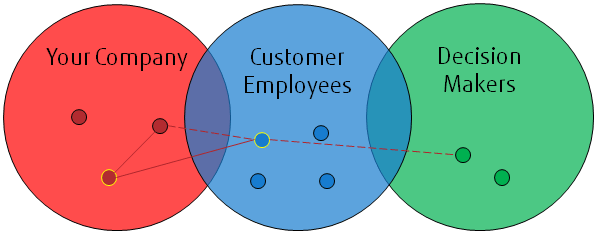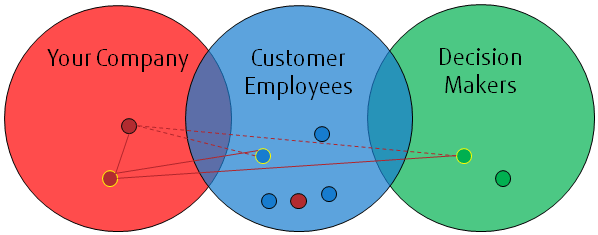Social Selling is a technique to enhance Sales by using social media and Employee Advocacy. but how does it really work?
In Sales there are two main techniques in trying to get your wares to the customer. Using one, you send out your advertisements and sales pitches to as many people as possible, without having any prior connection with or knowledge of your customer. Another way is to find out what your customer wants and needs, and specifically target them. And word of mouth as well as testimonials from friends, families and colleagues are great ways of getting the knowledge of your products and expertise to your potential customers.
Online, in a digital marketplace, this is no different. If you send connection requests on Linkedin to decision makers without custom message, or immediately with a Sales pitch, you are likely to be ignored. You have no connection with them, no social proof. Even if you connect, the moment you spam their feeds with advertisements and pitches, they will remove you from their networks.
So this means it is very important to get “close to the customer” as the Sales always say. A lot of articles on Social Selling explain why it is so important, and that it allows for Sales to get closer, but how does it really work? Let’s find out, based on Linkedin.
The Linkedin Circle
People are not singular creatures, we live in social circles. People in companies connect to each other, and join groups that interest them. They Follow influencers who say important things, and respond to articles that people post. On Linkedin, if you are directly connected, this is called a Level 1 connection. This means your activities are show in each other’s feed and you can send each other messages. If you are connected to someone, all their direct connections are Level 2. You can send a connection request to them or Follow them, but not message them and they do not see you in their feed. Anyone else is a level 3 connection, meaning you cannot send requests to connect, and only ask for a Level 2 connection to introduce you to them.
This means that a Sales person is simply invisible to most people who are not direct connections, and that you have to work hard to get noticed.
Employee Advocacy
Now imagine that you gave great, professional employees in your company who are connected to you on Linkedin. They are posting interesting content, joining professional groups and connecting with people through these actions. Once they connect with someone in your potential customer’s company, something magical happens…
Because that person is connected to someone in that company, suddenly there is an overlap between social groups. They are now Level 1 connections with a customer employee, and because they are also connected with you, this makes that particular employee Level 2 for you as Sales. The colleague making this connection acts as a bridge for you, allowing you to send you own Connection requests to them without needing an introduction.
Everyone else in the company, including decision makers, are still level 3. However, you can already send some messages to your customer by having your well-connected colleague(s) share content that contains, mentions, or links through to information about your company and products. This means you can start making your potential customers aware of your existence and benefit to them.
Credible Professionals and High-Level Networking
The next phase happens when those connected (level 1 and level 2) employees are posting quality content that is, in turn, liked or commented on by people in the target company. Through their actions of Liking and Commenting, these articles are presented in the feeds of decision makers. This offers the opportunity for one of them to connect with that employee in your company based on shared interests or expertise.
At this point, that Employee is Level 1 connected with an influential decision maker, and by extension likely Level 2 to everyone else in the company. Because you are connected with each other, you as Sales are Level 2 connected to all of them in turn. Now you will have a much easier time researching, engaging and connecting with people in that company, including the decision makers determining what suppliers will be invited when a new request is placed in the market.
This is not an “automatic win” for the Sales people in your company – after all they still need to do their job, along with all the other departments involved in Presales – but it gives them powerful tools to engage with and influence the customer.
Why you need quality content
People are not interested in sharing marketing material, cold pitches and obvious advertisements. Rather, they want to share insights and commentary related to their professional life, industry and interests. So your content needs to be interesting to them, and be of sufficient quality that people will “Like” it or comment on it, or else it will remain invisible to the largest part of your extended network. Your content spreads primarily through those Likes and Comments, and any low-quality material vanishes quickly from people’s feeds. Great posts return, sometimes even years after they are made.
This also means that anyone can help to do Social Selling for your company. You are likely to share a job, interest or groups with people in companies that are potential customers. Your content has to be good not because you intend to spread it for this purpose, but because it is an independently awesome article. Good articles are shared on Linkedin, but great articles get shared far beyond it.
The dangers of social selling
Social Selling and engagement are great fun, and they can help kickstart or boost your career. But there are some things to realize before you jump in:
- Social Engagement takes time: You are not going to write great posts from day 1. You will need credibility and a professional attitude, things which grow over time and it also takes some time before people recognize you as a person. Only then does the second phase start, where you can engage with industry influencers. You also have to keep communicating, you can’t just post once a week and call it quits. You too have to Like, Comment and keep involved with groups.
- Sales should not be your goal: The content you make and the connections you create should be of value to you regardless of whether they would help you or your company sell. People are business-like on Linkedin, but it’s not just a sales network, it’s a professional network. If you don’t get enjoyment from talking to people and sharing insights, you will not keep it up for long.
- It works both ways: Just as you are connecting with high-level people in your (extended) network, others are connected to you. You are now also the bridge for them (or Sales they are connected to) to engage with you and your company in the same way. This means you have to be a bit careful about who you connect with when you start this, so that you don’t connect with a person who has all your competitor’s Sales team as their level 1 connection…
- Always focus on the quality: You want to build a reputation for professionalism, skill and insight. That should be your first and only priority, not to be a channel for Sales to spam your network with advertisements and canned content. It is their job to sell, your job to be awesome and be a beacon that attracts movers and shakers in the industry. Once you allow yourself to reduce the quality of your content, you may be dismissed as another soulless mouthpiece for your company’s marketing department.
Handling direct connections and requests for introductions
Once you are at a high level of connection, with an extended network, you can expect to be targeted routinely by people who want to send their pitch to you. They will either send a message with a pitch or meeting request, or invite you to connect first and (should you accept) start talking to you about business opportunities. This is normal, and something to learn to deal with.
When it comes to this, always be professional and clear. My policy is to explain that I do not engage in acquisitions, but am willing to direct them to our corporate contacts. Should they persist, I reiterate that they are engaging in Sales, Business Development or the like (see if there is anything in their message to this effect, and use this in your reply) and that I am not comfortable with their line of inquiry. People who are professional will thank you for your time, and likely you will never hear from them again. Unprofessional people simply fall silent or continue spamming you even after this – and that will also tell you all you need to know.
Handling this in a polite, professional manner is critical not just for your reputation, but also your company’s.
Introduction requests indicate that someone wants to connect with a first level connection in your network, who they have no relation to. I have never seen it, and I am not sure if it’s even done regularly (feel free to comment about it below!) because it makes it very clear that this is not about you but about who you know. On the whole I imagine it makes people uncomfortable and feel ignored.
If you receive one, make very sure that passing the connection on is in your, or your company’s, best interest. Otherwise it is best to simply decline, ignore it or ask further clarification from these people. This choice should really depend on who is trying to get introduced and their level of professionalism in asking for the introduction.
As with most companies, make sure you follow the social media guidelines, and if something seems strange or not right, contact your marketing department for help. They should be able to help you assess and respond in a proper manner.



